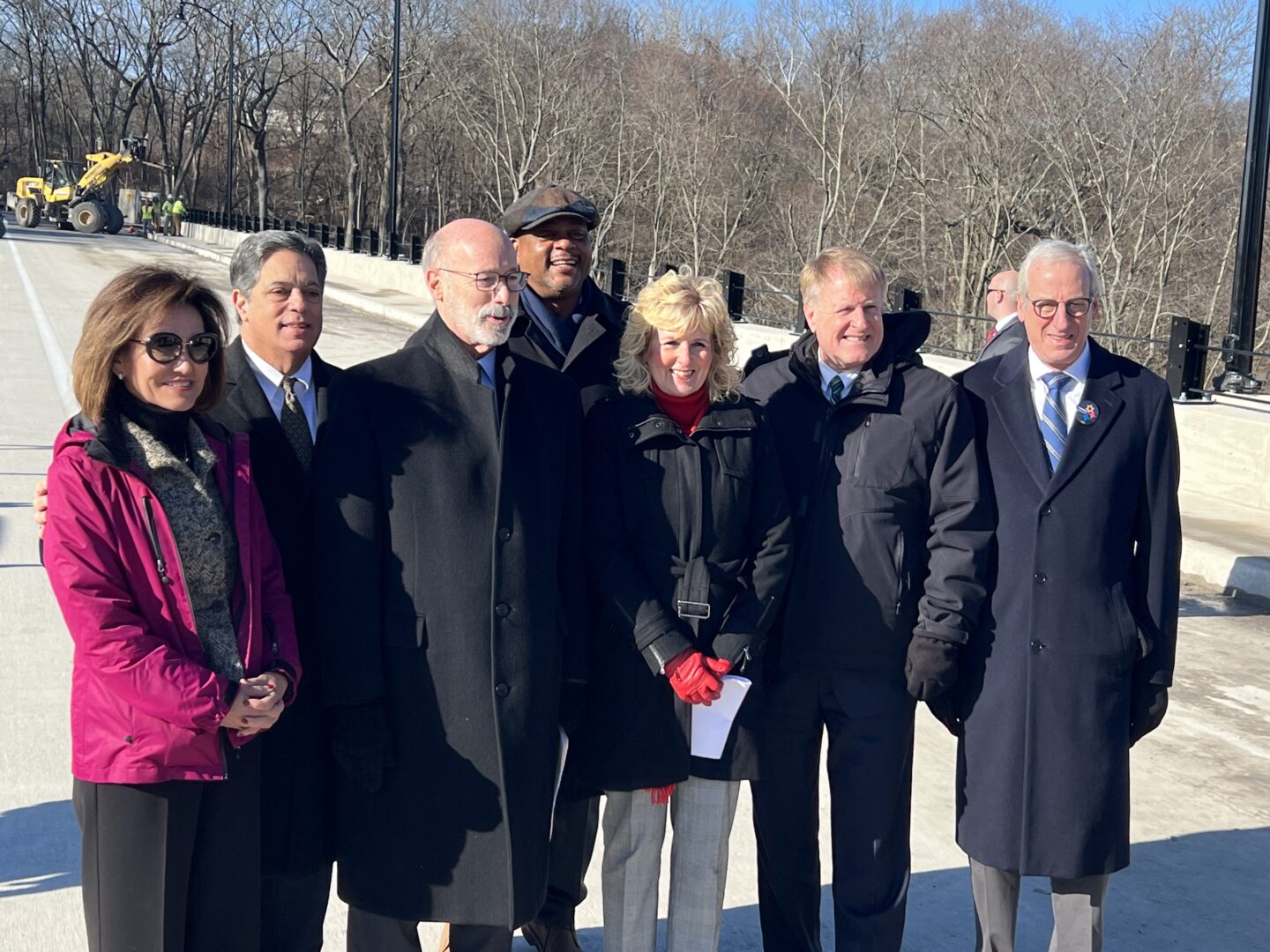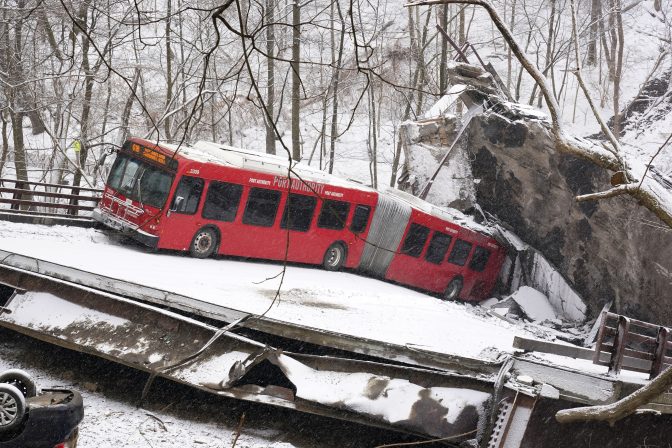
State and local officials at the ribbon cutting ceremony for the Fern Hollow Bridge on Dec. 21.
Katie Blackley / 90.5 WESA

State and local officials at the ribbon cutting ceremony for the Fern Hollow Bridge on Dec. 21.
Katie Blackley / 90.5 WESA

Katie Blackley / 90.5 WESA
State and local officials at the ribbon cutting ceremony for the Fern Hollow Bridge on Dec. 21.
A critical connection between Pittsburgh’s Squirrel Hill and Regent Square neighborhoods was restored this morning as Governor Tom Wolf, Mayor Ed Gainey, Allegheny County Executive Rich Fitzgerald, PennDOT secretary Yassmin Gramian, and other local and state officials dedicated the new Fern Hollow Bridge.
At the ceremony, Gramian thanked President Biden for the infrastructure bill, Wolf for the emergency declaration to deliver the project with speed, and the city for its contributions.
“This is a clear example of having enough funding for an infrastructure project,” Gramian said. “It’s providing such a huge opportunity … to address our needs in Pennsylvania.”
Wolf said that when the bridge collapsed, “It was a visceral reminder that Pennsylvania is in a race to repair its infrastructure… our communities, our people, deserve to know that they can rely” the facilities they use every day.” He added that rebuilding the bridge so quickly is an example of “a government that works for Pennsylvanians.”
In the early morning of Jan. 28, the 447-foot long span collapsed into Frick Park, taking a Pittsburgh Regional Transit bus and several cars with it. Nine people were injured, but there were no fatalities, which numerous public officials described as miraculous.
The Pennsylvania Department of Transportation estimates that the bridge daily carried some 21,000 cars. Later that day, President Joe Biden walked to the bridge’s edge and said to a gaggle of local, state and federal officials of the city’s bridges: “We are going to fix them all.”
Restoration for Fern Hollow happened much faster than its peers can expect.
PennDOT and its contractors — HDR, an international design firm, and Swank Construction — built the new bridge in just 11 months, thanks to emergency declarations and procedures that allowed them to bypass a traditional, years-long timeline that includes preliminary design, final design, community engagement, permitting and sending the project out to bid. Speaking last week, Cheryl Moon-Sirianni, who leads PennDOT’s District Eleven, said that bypass did not mean cutting corners.
“The time savings was a lot on the front end,” she said, when the agency and the contractor designed a bridge with “the material that was available.” She added that Fern Hollow has “a higher factor of safety,” than it strictly needs; in order to keep the process moving as quickly as possible, they designed and built with “some conservative engineering guesses … so we wouldn’t have to go back.”
“I was only on the job three weeks!” – Gainey reflects on the January 2021 collapse. This is Gainey’s first year as mayor. He also says the much-anticipated city bridge report is complete. pic.twitter.com/cYlkhnBhUt
— Katie Blackley (@kate_blackley) December 21, 2022
The speed of Fern Hollow’s restoration can not — and will not — become PennDOT’s new normal, Moon-Sirianni stressed. It was an emergency.
“There’s a lot of folks that work very, very quickly when something is an emergency,” she said, reeling off as examples PennDOT’s central office, PennDOT’s bridge specialist and the Federal Highway Administration. “You can only have so many emergencies.”
Though the Fern Hollow Bridge will once again be open, car travel on it will be restricted this winter to just one lane in each direction while Swank Construction installs new light poles and builds a pedestrian crossing to the Frick Park gatehouse on the bridge’s southern side. A shared-use path for cyclists and pedestrians, also on the southern side, will be open, while the northern sidewalk will not. Because those efforts are ongoing, Moon-Sirianni said the total price tag is not yet clear, but that PennDOT hopes to remain under the allocated $25.3 million.
More of the bridge pic.twitter.com/ldqfEAtSxR
— Katie Blackley (@kate_blackley) December 21, 2022
Why the Fern Hollow Bridge collapsed remains the subject of investigation by the National Transportation Safety Board, which opened its inquiry hours after the bridge’s demise. At the time, officials said that process could take up to 18 months, though the NTSB occasionally releases updates. The last, released in May, described the sequence of events leading to the collapse and found no “widespread deficiencies.”
The need to rebuild the Fern Hollow Bridge seemed to many advocates an opportunity to improve a critical piece of the city’s infrastructure. Some efforts, such as one to ensure the bridge’s design wasn’t just another “highway overpass,” ultimately failed; others, such as a push for better cycling and pedestrian connections, succeeded.

Gene J. Puskar / AP
This is a Pittsburgh Transit Authority bus that was on the Fern Hollow Bridge in Pittsburgh when it collapsed Friday morning Friday, Jan. 28, 2022. (AP Photo/Gene J. Puskar)
Others worried about how PennDOT and Swank would care for the natural environment below the bridge: The restoration of Nine Mile Run took years, and environmentalists raised concerns about how construction could mean a setback or create new problems. Officials from the state Department of Environmental Protection and the Allegheny County Conservation District said they would be watching the work closely. PennDOT and its contractor will begin restoration of the park soon, Moon-Sirianni said.
Fern Hollow is just one of 147 bridges the City of Pittsburgh maintains. In July, the city hired WSP Global to assess those bridges and compile a report, which was made public on Wednesday.
The city’s 2023 operating budget includes funding for a bridge management program and creates a new position, Bridge Maintenance Supervisor, in the city’s Department of Mobility and Infrastructure, or DOMI.
DOMI’s chief engineer, Eric Setzler, told city councilors in a budget hearing this month that hiring that supervisor is a “first step … to get more done quicker and at a lower cost,” when it comes to the city’s maintenance efforts.
DOMI Director Kim Lucas expects that position to be posted in the first quarter of the new year, once it goes through all the necessary approvals. However, during the same budget hearing, Lucas confirmed to councilors that it is difficult to fill the department’s open positions.
“We are nowhere near the staffing levels nor the compensation levels that we need to be competitive,” she said. “The job market is tough for everybody right now, but I can tell you we’ve got positions we’ve posted with zero candidates.”
The days of journalism’s one-way street of simply producing stories for the public have long been over. Now, it’s time to find better ways to interact with you and ensure we meet your high standards of what a credible media organization should be.